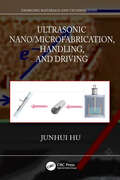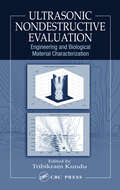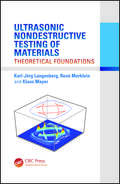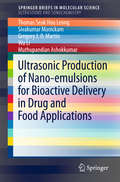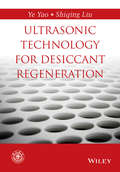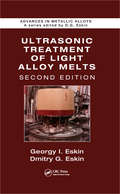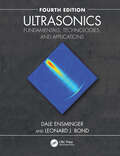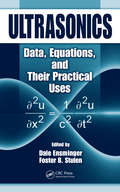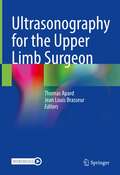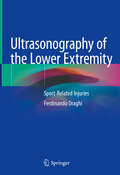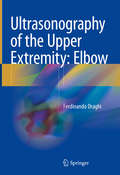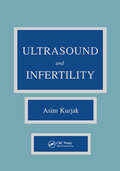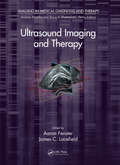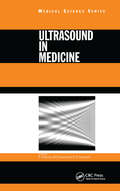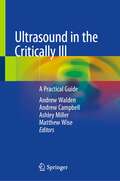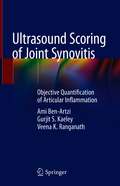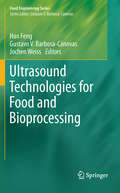- Table View
- List View
Ultrasonic Guided Waves in Solid Media
by Joseph L. RoseUltrasonic guided waves in solid media have become a critically important subject in nondestructive testing and structural health monitoring, as new faster, more sensitive, and more economical ways of looking at materials and structures have become possible. This book will lead to fresh creative ideas for use in new inspection procedures. Although the mathematics is sometimes sophisticated, the book can also be read by managers without detailed understanding of the concepts as it can be read from a 'black box' point of view. Overall, the material presented on wave mechanics - in particular, guided wave mechanics - establishes a framework for the creative data collection and signal processing needed to solve many problems using ultrasonic nondestructive evaluation and structural health monitoring. The book can be used as a reference in ultrasonic nondestructive evaluation by professionals and as a textbook for seniors and graduate students. This work extends the coverage of Rose's earlier book Ultrasonic Waves in Solid Media.
Ultrasonic Nano/Microfabrication, Handling, and Driving (Emerging Materials and Technologies)
by Junhui HuUltrasonic nano/microfabrication, handling and driving is an emerging actuation technology, which utilizes ultrasonic vibration and the physical effects of ultrasonic vibration in fluids and solids to implement the fabrication, handling and driving of nano/micro scale objects. This book provides readers with the fundamentals, principles and characteristics of the ultrasonic devices for nano/micro fabrication, handling and driving, and design methods of the devices. • Introduces fundamental concepts and offers examples of ultrasonic nano fabrication, including ultrasonic nano rolling, cutting and coating methods. • Features a wealth of examples to illustrate the ultrasonic concentration and ultrasonic tweezers. • Explains the principles of ultrasonic driving of gas molecules and demonstrates their applications in high-performance gas sensor systems and metal-air flow batteries. • Teaches the principles of ultrasonic driving of microfluids and their applications in metal-air flow batteries and cooling of small solid heat sources. • Provides examples for the finite element method (FEM) modeling and computation of ultrasonic devices for nano/micro fabrication, handling and driving. • Summarizes the current and future trends in ultrasonic nano/microfabrication, handling, and driving. This book shares the advances, methods and applications of ultrasonic micro/nano fabrication techniques for entry-level and advanced readers working on nano/microfabrication, gas sensing, biological sensing, metal-air batteries, electronic component cooling, and other related areas.
Ultrasonic Nondestructive Evaluation: Engineering and Biological Material Characterization
by Tribikram KunduMost books on ultrasonic nondestructive evaluation (NDE) focus either on its theoretical background or on advanced applications. Furthermore, information on the most current applications, such as guided wave techniques and acoustic microscopy, is scattered throughout various conference proceedings and journals. No one book has integrated these aspe
Ultrasonic Nondestructive Testing of Materials: Theoretical Foundations
by Klaus Mayer Karl-Jörg Langenberg René MarkleinUltrasonic Nondestructive Testing of Materials: Theoretical Foundations explores the mathematical foundations and emerging applications of this testing process, which is based on elastic wave propagation in isotropic and anisotropic solids. In covering ultrasonic nondestructive testing methods, the book emphasizes the engineering point of view, yet
Ultrasonic Production of Nano-emulsions for Bioactive Delivery in Drug and Food Applications (Springerbriefs In Molecular Science: Chemistry of Foods)
by Sivakumar Manickam Wu Li Muthupandian Ashokkumar Thomas Seak Leong Gregory J. MartinThis SpringerBrief provides an overview of ultrasonic emulsification and an update on recent advances in developing stable emulsions for the creation of novel drugs and functional foods, with a focus on bioactive delivery in these products.Emulsification is the process of combining two or more immiscible liquids to form a semi-stable mixture. These two liquids generally consist of an organic (oil) phase and an aqueous (water) phase that is stabilized by the addition of an emulsifier. Most common emulsions are of the oil-in-water (O/W) type, but can also be of water-in-oil (W/O) or even multiple emulsion types (i.e. double emulsions) in the form of water-in-oil-in-water (W/O/W) or oil-in-water-in-oil (O/W/O) phases. The formation of an emulsion requires input of energy to distribute the disperse phase in the continuous phase in small-sized droplets that are able to resist instability. There is great interest in the use of ultrasound to produce emulsions, as it is able to do so relatively efficiently and effectively compared to existing techniques such as rotor stator, high-pressure homogenization and microfluidization. The interaction of ultrasound with the hydrocolloids and biopolymers that are often used to stabilize emulsions can offer advantages such as improved stability or greater control of formed droplet size distributions.
Ultrasonic Spectroscopy: Applications in Condensed Matter Physics and Materials Science
by Robert G. LeisureUltrasonic spectroscopy is a technique widely used in solid-state physics, materials science, and geology that utilizes acoustic waves to determine fundamental physical properties of materials, such as their elasticity and mechanical energy dissipation. This book provides complete coverage of the main issues relevant to the design, analysis, and interpretation of ultrasonic experiments. Topics including elasticity, acoustic waves in solids, ultrasonic loss, and the relation of elastic constants to thermodynamic potentials are covered in depth. Modern techniques and experimental methods including resonant ultrasound spectroscopy, digital pulse-echo, and picosecond ultrasound are also introduced and reviewed. This self-contained book includes extensive background theory and is accessible to students new to the field of ultrasonic spectroscopy, as well as to graduate students and researchers in physics, engineering, materials science, and geophysics.
Ultrasonic Synthesis of Functional Materials
by Muthupandian AshokkumarThis book begins by giving a summary of sonochemistryand explains how a chemical reaction can be induced by the interaction of soundwaves and gas bubbles in liquids. The work outlines how primary and secondaryradicals combined with the physical effects generated during acousticcavitation are active in the ultrasonic synthesis of a variety of functionalmaterials. The brief covers hot topics that include ultrasonic synthesis ofvarious functional materials covering the following broad areas: acoustic cavitationand sonochemistry, synthesis of functional polymers and their applications, synthesisof functional inorganic materials and their applications, improving functionality of food/dairy systems, synthesis of functionalbiomaterials and their applications, synthesis of graphene based catalytic materials. Theory is kept to a minimum. The book is aimed at individuals at universitiesand will also interest those in industry. It is suitable for all levels.
Ultrasonic Technology for Desiccant Regeneration
by Shiqing Liu Ye YaoThe chapters in this volume explore ultrasound-assisted regeneration of silica gel, ultrasound-assisted regeneration for a new honeycomb desiccant material, ultrasound-atomizing regeneration for liquid desiccants, ultrasonic transducers, and much more.
Ultrasonic Treatment of Light Alloy Melts (Advances in Metallic Alloys)
by Georgy I. Eskin Dmitry G. EskinSpawned by growing interest in ultrasonic technology and new developments in ultrasonic melt processing, the Second Edition of Ultrasonic Treatment of Light Alloy Melts discusses use of ultrasonic melt treatment in direct-chill casting, shape casting, rapid solidification, zone refining, and more, exploring the effects of power ultrasound on melt d
Ultrasonics: Fundamentals, Technologies, and Applications, Third Edition
by Dale Ensminger Leonard J. BondThe book provides a unique and comprehensive treatment of the science, technology, and applications for industrial and medical ultrasonics, including low- and high-power implementations. The discussion of applications is combined with the fundamental physics, the reporting of the sensors/transducers, and systems for the full spectrum of industrial, nondestructive testing, and medical/bio-medical uses. It includes citations of numerous references and covers both mainstream and the more unusual and obscure applications of ultrasound.
Ultrasonics: Fundamentals, Technologies, and Applications (Mechanical Engineering Ser.)
by Dale Ensminger Leonard J. BondUpdated, revised, and restructured to reflect the latest advances in science and applications, the fourth edition of this best-selling industry and research reference covers the fundamental physical acoustics of ultrasonics and transducers, with a focus on piezoelectric and magnetostrictive modalities. It then discusses the full breadth of ultrasonics applications involving low power (sensing) and high power (processing) for research, industrial, and medical use. This book includes new content covering computer modeling used for acoustic and elastic wave phenomena, including scattering, mode conversion, transmission through layered media, Rayleigh and Lamb waves and flexural plates, modern horn design tools, Langevin transducers, and material characterization. There is more attention on process monitoring and advanced nondestructive testing and evaluation (NDT/NDE), including phased array ultrasound (PAUT), long-range inspection, using guided ultrasonic waves (GUW), internally rotary inspection systems (IRIS), time-of-flight diffraction (TOFD), and acoustic emission (AE). These methods are discussed and applied to both metals and nonmetals using illustrations in various industries, including now additionally for food and beverage products. The topics of defect sizing, capabilities, and limitations, including the probability of detection (POD), are introduced. Three chapters provide a new treatment of high-power ultrasonics, for both fluids and solids, and again, with examples of industrial engineering, food and beverage, pharmaceuticals, petrochemicals, and other process applications. Expanded coverage is given to medical and biological applications, covering diagnostics, therapy, and, at the highest powers, surgery.Key Features Provides an overview of fundamental analysis and transducer technologies needed to design and develop both measurement and processing systems Considers applications in material characterization and metrology Covers ultrasonic nondestructive testing and evaluation and high-power ultrasonics, which involves interactions that change the state of material Highlights medical and biomedical applications of ultrasound, focusing on the physical acoustics and the technology employed for diagnosis, therapy, surgery, and research This book is intended for both the undergraduate and graduate scientists and engineers, as well as the working professional, who seeks to understand the fundamentals together with a holistic treatment of the field of ultrasonics and its diversity of applications.
Ultrasonics: Data, Equations and Their Practical Uses
by Dale Ensminger Foster B. StulenGain a Unique and Comprehensive Understanding of UltrasonicsDespite its importance, most books on ultrasonics cover only very specific sub-fields of the science. They generally also take a more mathematical approach and lack the wider scope needed to truly improve understanding and facilitate practical use of ultrasonics across a wide range of disc
Ultrasonography for the Upper Limb Surgeon
by Thomas Apard Jean Louis BrasseurThis book combines orthopedists’ and radiologists’ perspectives to provide a comprehensive overview of the rapidly expanding use of ultrasound in orthopedic surgery. It also highlights the growing awareness of the potential of this non-invasive and portable, real-time imaging tool, which has led to its inclusion in the minimally invasive toolkit of upper limb surgeons.The book is divided into five parts – shoulder, elbow, forearm, hand and wrist and fingers. Each part focuses on a particular anatomic region or joint, carefully analyzing the sonoanatomy of its nerves, tendons and bones. For each region, experienced experts illustrate how to perform specific techniques under ultrasound control, ranging from classic procedures, like carpal tunnel release, to the treatment of less common conditions. Covering all the basic and practical aspects of this innovative, multi-disciplinary approach, as well as future perspectives, this unique book is a must-read for all orthopedists, radiologists, sports physicians and physiotherapist wanting to gain insights into this promising field.
Ultrasonography of the Lower Extremity: Sport-Related Injuries
by Ferdinando DraghiThis book provides a detailed overview of ultrasound imaging of sport-related injuries of the lower extremity. The available literature focuses mainly on either clinical aspects or all imaging modalities and clinical aspects of sport-related pathologies, with little relevance on ultrasound. Indeed, recent advances in ultrasound technology, including high resolution, electronic, broadband transducers, have led to improved assessment of the musculoskeletal system, and ultrasound is now considered an optimal imaging technique to evaluate musculoskeletal sport-related injuries. Its advantages include the ability to perform dynamic examinations essential for many diagnoses, such as intrasheath instability of the peroneal tendons.Drawing on the author’s over 30 years of experience in clinical praxis, this book highlights the great potential of the ultrasonographic evaluation of sports-related injuries and is entirely devoted to this technique. Similar to the two previous monographs by the same author, the book has the form of an atlas-text, with a wealth of high-quality ultrasound images and schemes – a structure that has proved particularly effective for learning, especially for younger physicians. Ultrasonography of the lower extremity: sport-related injuries combines the interests of various specialists, including radiologists, physiatrists, orthopedists, rheumatologists, and ultrasound technicians.
Ultrasonography of the Upper Extremity: Elbow
by Ferdinando DraghiThis book on elbow ultrasonography is a practice-oriented book, offering a wealth of high-quality ultrasound images, and providing clear, concise, and comprehensive coverage of the normal anatomy as well as the main pathologic conditions of the elbow. The ultrasound images have been obtained using state-of-the-art scanners and carefully labeled to facilitate recognition of each condition. The book also provides a helpful comparison of the images and findings obtained using other diagnostic techniques, including magnetic resonance imaging. The text is complemented by practical tables summarizing key points for ease of reference. Ultrasonography of the Upper Extremity: Elbow is a rich source of information on the anatomy, examination techniques and ultrasound appearances of one of the anatomic regions to have benefited most from the technological revolution that has taken place in the field of ultrasonography in recent years. The book appeals to both novice and experienced practitioners, including above all radiologists and ultrasound technicians, as well as rheumatologists and orthopedic surgeons.
Ultrasound Anatomy of Lower Limb Muscles: A Practical Guide
by Enzo Silvestri Alessandro Muda Davide OrlandiThe book provides a comprehensive description of the basic ultrasound principles, normal anatomy of the lower limb muscles and classification of muscle strain injuries. Ultrasound images are coupled with anatomical schemes explaining probe positioning and scanning technique for the various muscles of the thigh and leg. For each muscle, a brief explanation of normal anatomy is also provided, together with a list of tricks and tips and advice on how to perform the ultrasound scan in clinical practice. This book is an excellent practical teaching guide for beginners and a useful reference for more experienced sonographers.
Ultrasound and Carotid Bifurcation Atherosclerosis
by Efthyvoulos Kyriacou Kirk W. Beach Constantinos S. Pattichis Andrew NicolaidesUltrasound and Carotid Bifurcation Atherosclerosis provides a comprehensive overview of the most recent advancements in instrumentation, imaging techniques including the use of contrast enhancement agents, plaque image analysis and its automation, elastography and plaque motion analysis; also, the use of ultrasonic and other biomarkers in the detection of the high risk cardiovascular individual. Finally, it deals with the application of IVUS, TCD and carotid plaque characterization in clinical practice and in stroke risk stratification. Ultrasound and Carotid Bifurcation Atherosclerosis is intended for all those working in the field of atherosclerosis, ultrasound imaging and cardiovascular risk, including the clinician, the vascular ultrasonographer, the epidemiologist, the molecular biologist, the biomedical engineer and the informatics scientist. Furthermore, this book bridges the gap between the researcher and the clinician, who is keen to incorporate the latest results of research to his daily practice.
Ultrasound and Infertility
by Asim KurjakA comprehensive survey of the use of ultrasound in management of infertile patients is presented in this publication. Particular atten-tion is given to recently developed techniques such as assessment of endometrial changes, ovarian blood flow measurements, and per-cutaneous oocyte retrieval for in vitro fertilization. The very re-cent technique of transvaginal sonography is presented and richly illus-trated with original results obtained in biopsy-guided oocyte re-trieval, and in the precise delineation of follicle size and number for infertility treatment. Guidance in the interpretation of ultrasonic findings, which include potential limitations and pitfalls, is provided in each chapter. Researchers and practitioners interested in the management of infertile patients will find this volume indispensable.
Ultrasound Energy and Data Transfer for Medical Implants (Analog Circuits and Signal Processing)
by Francesco Mazzilli Catherine DehollainThis book presents new systems and circuits for implantable biomedical applications, using a non-conventional way to transmit energy and data via ultrasound. The authors discuses the main constrains (e.g. implant size, battery recharge time, data rate, accuracy of the acoustic models) from the definition of the ultrasound system specification to the in-vitro validation.The system described meets the safety requirements for ultrasound exposure limits in diagnostic ultrasound applications, according to FDA regulations. Readers will see how the novel design of power management architecture will meet the constraints set by FDA regulations for maximum energy exposure in the human body. Coverage also includes the choice of the acoustic transducer, driven by optimum positioning and size of the implanted medical device. Throughout the book, links between physics, electronics and medical aspects are covered to give a complete view of the ultrasound system described.Provides a complete, system-level perspective on the use of ultrasound as energy source for medical implants;Discusses system design concerns regarding wireless power transmission and wireless data communication, particularly for a system in which both are performed on the same channel/frequency;Describes an experimental study on implantable battery powered biomedical systems;Presents a fully-integrated, implantable system and hermetically sealed packaging.
Ultrasound-Guided Procedures in Equine Orthopedics and Surgery
by Roberto J. EstradaThis book serves as a practical guide for equine veterinarians in orthopedics and surgery. It reviews and summarizes the current scientific evidence of the most commonly performed ultrasound-guided procedures for ultrasound-assisted surgery and injections.For the first time, different techniques are compiled and richly illustrated with pictures and videos to guide the practitioner step-by-step. An initial discussion about the general principles of ultrasound-guided procedures sets the bases for clinicians to understand the general technique and apply it to each approach. Additional chapters describe the most common ultrasound-guided injections in different anatomical structures as well as the surgical approaches that are aided or guided with ultrasound.All over the world ultrasound-guided procedures are performed daily in many different fields of equine practice. The main objective of using these approaches is to increase accuracy and minimize tissue trauma when performing diagnostic and therapeutic procedures. Equine orthopedics and surgery are among the major applications of these techniques.Learn about ultrasound-assisted techniques and be part of this trend! Maximize your capacity as a veterinarian, directly affecting the health of your patients. You can access the supplementary videos directly on your smartphone or tablet; simply download the Springer Nature More Media App for free and scan the links with the play button.
Ultrasound Imaging and Therapy (Imaging In Medical Diagnosis And Therapy Ser.)
by Aaron Fenster James C. LacefieldUp-to-Date Details on Using Ultrasound Imaging to Help Diagnose Various DiseasesDue to improvements in image quality and the reduced cost of advanced features, ultrasound imaging is playing a greater role in the diagnosis and image-guided intervention of a wide range of diseases. Ultrasound Imaging and Therapy highlights the latest advances in usin
Ultrasound in Medicine (Series in Medical Physics and Biomedical Engineering)
by Francis A Duck Andrew C Baker Hazel C StarrittUltrasound in Medicine is a broad-ranging study of medical ultrasound, including ultrasound propagation, interaction with tissue, and innovations in the application of ultrasound in medicine. The book focuses specifically on the science and technology-the underlying physics and engineering. It examines the most closely related aspects of these basic sciences in clinical application and reviews the success of technological innovations in improving medical diagnosis and treatment. The book bridges the gap between tutorial texts widely available for ultrasound and medical training and theoretical works on acoustics.
Ultrasound in the Critically Ill: A Practical Guide
by Andrew Walden Andrew Campbell Ashley Miller Matthew WiseThis book provides a practically applicable guide to the use of ultrasound in the care of acutely and critically ill patients. It is laid out in two sections. The first section attempts to take a comprehensive approach to specific systems of examination taking an organ focused approach covering techniques including Focussed Assessment with Sonography for Trauma (FAST) scanning and venous sonography. The second section presents a range of specific cases enabling the reader to develop an understanding of how to apply these methodologies effectively into their day-to-day clinical practice.Ultrasound in the Critically Ill: A Practical Guide describes how to use ultrasound technologies in day-to-day clinical practice. Therefore, it is an ideal resource for all trainee and practicing physicians who utilize these technologies on a day-to-day basis.
Ultrasound Scoring of Joint Synovitis: Objective Quantification of Articular Inflammation
by Ami Ben-Artzi Gurjit S. Kaeley Veena K. RanganathA common manifestation of many autoimmune diseases is joint inflammation. The degree of inflammation of the joints is often used as a metric of disease activity. Assessing disease activity has diagnostic, therapeutic, and prognostic implications. Inflammation of the joints is often used as a proxy for inflammation in other tissue, and assessing this inflammation has implications for the health of numerous organs in in the body. Currently, physicians use palpation of joints to assess for joint inflammation. This method, while accessible and easy to apply, is lacking in precision. Ultrasound has also been used to assess for joint inflammation for over 20 years, but applying ultrasound technology has proved challenging. There is lack of agreement on optimal joint view, which joints should be examined in which disease, and how inflammation should be graded. Various scanning protocols and grading schemes have been proposed, but each has its strengths and weaknesses. Ultrasound Scoring of Joint Synovitis is based off the work of three authors who tackled the limitations of contemporary inflammation scoring systems, and developed an ultrasound-based inflammation scoring system which can be applied with consistency and reproducibility. In their research, the authors scanned thousands of joints and spent thousands of hours discussing the scans. They produced a scoring system which will allow the user of the atlas to grade joint inflammation in a way that is less subjective and more reproducible than the current systems used. Objective descriptions allow the user to quantify sonographic signs of joint inflammation with an intentional bias for the more clinically relevant features of ultrasound pathology. For students of musculoskeletal ultrasound, the book offers detailed descriptions of the sonographic appearance of every level of joint inflammation. For researchers, the book, and the system laid out in the book, are truly state-of-the-art and will enable better precision in research and clinical care of patients with joint inflammation.
Ultrasound Technologies for Food and Bioprocessing
by Hao Feng Jochen Weiss Gustavo Barbosa-CanovasTraditional food and bioprocessing technologies are facing challenges due to high expectation from the consumers and producers for better quality and safety, higher process efficiency, and products with novel properties or functionalities. For this reason, in the last few years new forms of physical energies have been explored to propose alternatives to traditional processing technologies. Acoustic energy has the potential to replace or partially substitute conventional processes, and at the same time offer unique opportunities in the characterization of foods and biomaterials. This book is a resource for experts and newcomers in the field of power ultrasound, gives insights into the physical principles of this technology, details the latest advancements, and links them to current and potential applications in the food and bioprocessing related industries.

